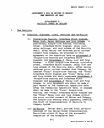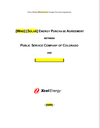Due in part to the low cost of photovoltaic system hardware and scalability for deployment, grid-connected distributed photovoltaic (DPV) technologies are increasingly permeating global power markets. While this trend could help substantially reduce the carbon footprint of global power generation, empower citizens across the socio-economic spectrum, and expand local PV markets, there are a number of technical and policy issues—especially in countries that have limited technical resources and need to “get things right” the first time.
The workshop provided and opportunity for Asia Clean Energy Forum participants to gain knowledge and tools to enable a clean, modern, flexible, and affordable power system.
The International Energy Agency recently released a new report titled "Status of Power System Transformation 2018: Advanced Power Plant Flexibility".
The Hawaiian Electric Light Company (HELCO) recently released their new models for Power Purchase Agreements for Renewable Dispatchable Generation for wind and solar PV.
Xcel Energy has released their new Model Power Purchase Agreement for Wind and Solar Generators, their Model Power Purchase Agreement for Semi-Dispatchable Renewable Resources and the Request for Proposals for Semi-Dispatchable Renewable Resources.
A recording of the webinar "Best Practices for Grid Codes for Renewable Energy Generators" has been published. The webinar explains in detail the purpose and key elements of grid codes, explores the evolving challenges to the grid that have prompted new and more rigorous grid codes and highlights the development of grid codes within the United States and internationally.
The National Renewable Energy Laboratory has released a new report titled "An Introduction to Grid Services: Concepts, Technical Requirements, and Provision from Wind". The report details the issues surrounding the provision of key ancillary services for grid reliability and stability by wind energy generators.
A recording of the webinar "Utility-Scale Battery Storage: When, Where, Why and How Much?" has been published. The webinar introduced key concepts for understanding the value of BESS; reviewed the services they can provide to the grid; and explored when, where, why and how BESS can be deployed economically.
For a little over three years, Parallel18 has worked with 168 tech-based start-ups, each of which receive $40,000 in equity-free funding, co-working space and coaching.
California utility PG&E is planning on blackouts during high wind events in wildfire season to prevent serious damage to the power system. While some communities are preparing backup plans such as microgrid networks and some residential customers have invested in solar and battery storage systems, the blackouts would come as a change and shock to many in the state.

















